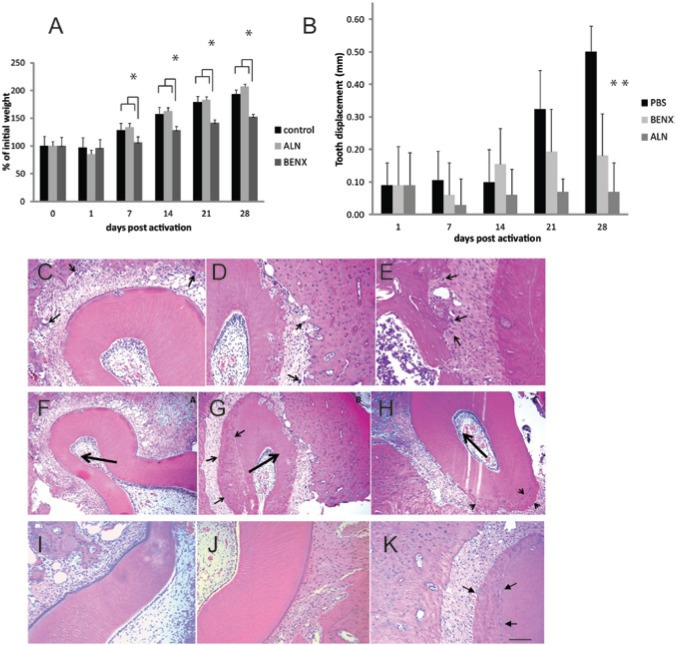Figure 4.
BE blocks orthodontic tooth movement in a rat model. Rats were subcutaneously injected with vehicle, alendronate 1 mg/kg/day, or BE 25 mg/kg/day for 2 wks prior to the activation of appliances and for 4 wks during orthodontic force application. (A) Rats in all 3 treatment groups gained weight after activation of the orthodontic apparatus. Ten animals per group were weighed; the groups were averaged and normalized to the pre-activation weight of each group. Note that although all 3 groups showed a slight decline in weight after activation, all groups subsequently gained weight consistently. (B) Both BE (BENX) and alendronate (ALN) reduced orthodontic tooth movement compared with vehicle, a result consistent with the inhibition of osteoclast bone resorption. The difference between alendronate and BE was not significant. Maxillae were collected after 28 days of orthodontic force application, fixed, and prepared for histology. Orthodontically treated sides of control rats (C), alendronate-treated rats (D), and BE-treated rats (E) displayed abundant osteoclasts, indicated by arrows in the H&E-stained sections. Hypercementosis (indicated by arrows) was evident in all rats (4 per group) treated with alendronate (G) and BE (H). Hypercementosis was less conspicuous in controls and detected in only 2 of the 4 control rats (F). The direction of orthodontic force application is indicated by the large arrow. Generally, as expected, osteoclasts were more abundant on the pressure side of teeth. Hypercementosis tended to occur on the tension side. Panels I-K are examples from the non-orthodontically treated sides of rats. Vehicle-treated rats (I) showed few osteoclasts or hypercementosis. BE- (J) and alendronate-treated rats also displayed few osteoclasts. However, all alendronate-treated rats exhibited hypercementosis even without orthodontic force application. The scale bar in K is equal to 80 µm in C-E and I-K and 130 µm in F-H.

